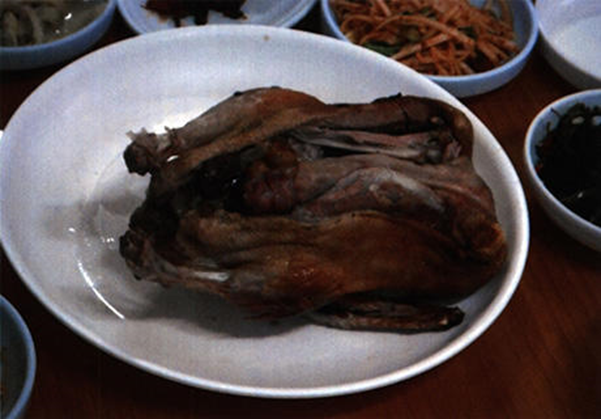Gourmand Dietary Culture
- TOP
- ESSAYS
- Gourmand Dietary Culture
- Eating Lacquer Tree
Eating Lacquer Tree
vesta No. 78
Cooked chicken [ottaku]
Last November, Professor Gourmand went on a trip to Sunchang County in South Korea. Sunchang is known for its red chilli miso paste called gochujang. Sunchang and Jeju are both known for being home to people with high-longevity.
I attended a symposium, jointly organised by Seoul University and Sunchang Countycalled "The Role of Traditional Food in Health and Longevity." As a post-symposium excursion, we went to visit of 107-year-old woman living in a mountain village in Sunchang County.
At the bottom of the farm garden, a white-haired old woman was taking soybeans out of their pods. The key to longevity is apparently opening a couple of small 200 ml bottles of shochu. This was obviously welcome news to Professor Gourmand, who is regularly scolded by his guardian for drinking excessively, despite his age. I was happy to have a pretext for continuing to drink sake so much for older people.
On the bus on the way back, a Professor of anthropology from Seoul University, Son Senamu (全京秀) asked me "Gourmand, have you ever tried lacquer tree?" Apparently if you touch a lacquer tree, you get a rash, I responded. But surely eating it, you don't get a rash on your throat and stomach? "No, you don't," he replied. So, he took us all to dinner at a countryside restaurant that specialised in lacquer-based recipes.
The name of the dish is ottaku. In Chinese characters it's written 漆鶏, which literally translates as cooked chicken. In Chinese medicinal terms, it's meant to boost liveliness, aid the digestion, and work as a pick-me-up. The chicken is boiled whole, wings and all, then cut up with scissors on a table. When you cut open its breast, it's densely stuffed with garlic.
To make it, you stuff the chicken with garlic, then boil it for three hours in water with lacquer bark, to give it flavour. The soup ends up a reddish-brown colour. The bark, with its medicinal benefits extracted through boiling, is taken out before the soup is served.
The meat's slightly bitter flavour is not so different from the normal taste of chicken. But the important part of it is the soup. It smells a little like Chinese medicine, and has the complex flavour of bitterness mixed with the sweetness of the chicken fat. I didn't feel it on my tongue, but occasionally the soup hit the mucous membrane at the back of my throat with a slight tingling sensation.
They showed me the bark they had boiled it up with it. The lacquer bark had been removed, cut into thin rectangles, and dried.
This dish is available across Korea, but apparently not that many people eat it. About 15 of us from the symposium went to this meal, but most people avoided ordering the ottaku, so in the end only about 5 of us ate it.
After returning to Japan, I researched it on the internet. Apparently ottaku can cause a full-body allergic reaction, producing a flair-up of dermatitis, damage to the liver and kidneys, and even, in severe instances, death. That's why, before eating it, everyone had checked whether I suffered allergies or not.
Among those eating the meal, was my friend Zhào Róng-Guan(趙栄光). Zhào is the lead researcher in Chinese culinary culture at Zhejiang Gongshang University, and the most eminent researcher of Chinese culinary history. When I asked him "do you know of any dishes in China that use the Lacquer tree?," he said "No, I don't."
Poison becomes medicine, according to the most important Eastern Chinese medicinal document, Dongui Bogam [literally, Priceless Book of Eastern Medicine], published in 1613 during Korea's Joseon Dynasty. Scouring a large number of books translated in Japanese, I only found 7 examples of lacquer tree being used. Most of them were instances of ganshitsu, or lacquer tree sap, hardened and roasted until it no longer emitted smoke, then ground into a powder, and prepared as another form of Chinese medicine. As most of the medicine recorded in Dongui Bogam is from China, China must also have used lacquer trees in a medicinal way. But the peasant dish that harnesses the medicinal qualities of lacquer trees is ottaku.
In Korea, they also cook using the sprouts of the lacquer tree. Even in Japan, those who cultivate lacquer trees often eat the sprouts as tempura. Apparently in Kyoto there's a restaurant that serves lacquer tree sprouts, so when they're in season, I'll go and check it out!

